Hi Everyone,

In January 2019, I posted a video about the Bill and Melinda Gates Foundation. The video I posted contained raw information directly from the Bill and Melinda Gates Foundation. I did not offer any further analysis or express any opinion of my own in that video or post. I decided it was best that my audience took in that information unadulterated to form their own opinions.
In this post, I provide my own analysis and express my own opinions based on information I have obtained regarding vaccinations. This post will not discuss the other aspects of the Bill and Melinda Gates Foundation.
Opening Statement
I would like to begin by stating that not all vaccines are the same. We should investigate different vaccines separately to determine their level of success and risk.
Flu vaccine
I will start with the influenza (flu) vaccine. The flu vaccine has been given a huge push over the last few years. This is largely because of the publicity various dangerous strains of flu such as the bird flu and swine flu have received; I will discuss this further in a few paragraphs. Flu is a common virus, most people will contract some form of flu at some point in their life. Flu also tends to be over-reported as well, people often mistake the common cold as a form of flu.
Most people recover from the flu with very little complications. However, there are some groups more vulnerable to the flu. Elderly people and young children are more likely to suffer worse symptoms and may even die.
Offering protection to those that are vulnerable seems like a good idea. This is where vaccines come in. The flu vaccine is intended to offer protection against particular strains of flu. So how effective is the flu vaccine? Figure 1 contains the effectiveness of the flu vaccine based on information provided by the Centres for Disease (CDC).
Figure 1: Effectiveness of Flu Vaccine
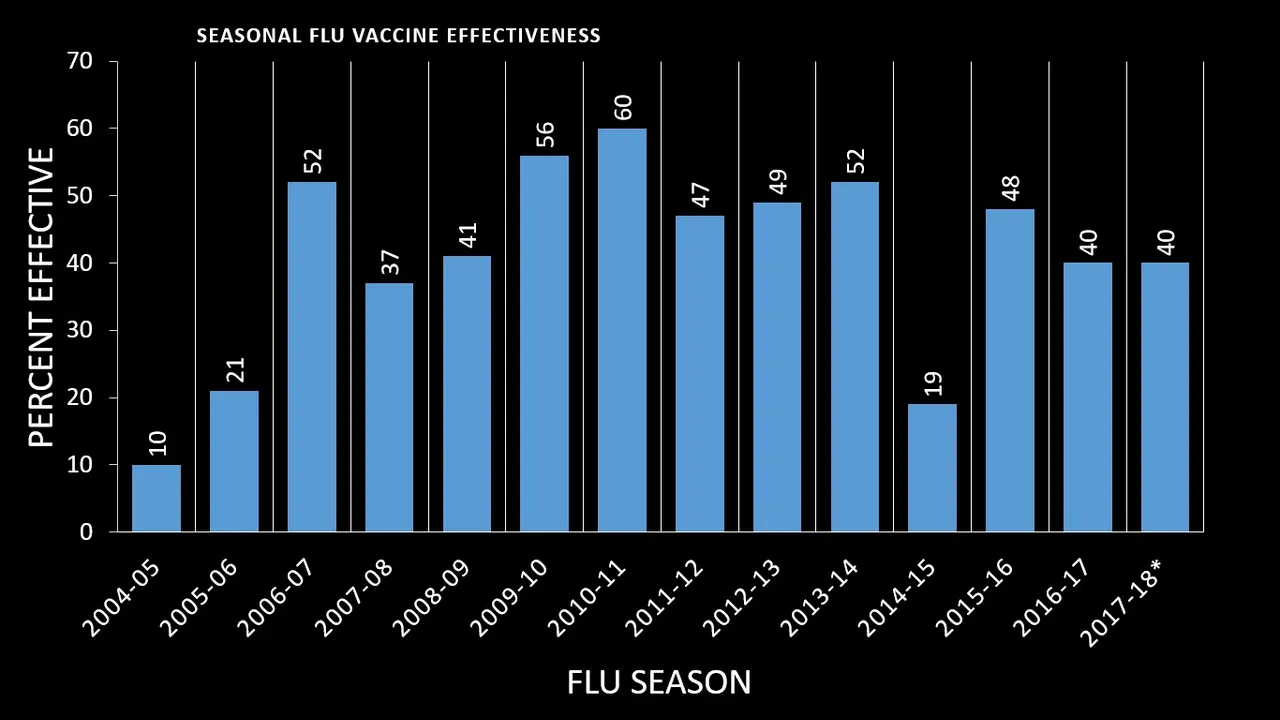
Source: CDC.gov
The results indicate that the flu vaccines have not been particularly effective. I would love to comment on the methodology used to determine these figures. Unfortunately, I do not have that information. All I know is that the results are a collection of various studies and the CDC claim that the lab tests used are highly accurate.
We have established that various groups of people with weaker immune systems are more likely to be vulnerable to the flu. It also appears that the flu vaccine is not very effective. I mentioned earlier that the dangers of flu have received more publicity in recent years. Is this because the number of cases of flu have increased and/or the number of fatalities are on the rise? Figure 2 contains the mortality rates for the flu and pneumonia in the USA from 1900 to the early 2000s.
Figure 2: Flu and Pneumonia mortality rates
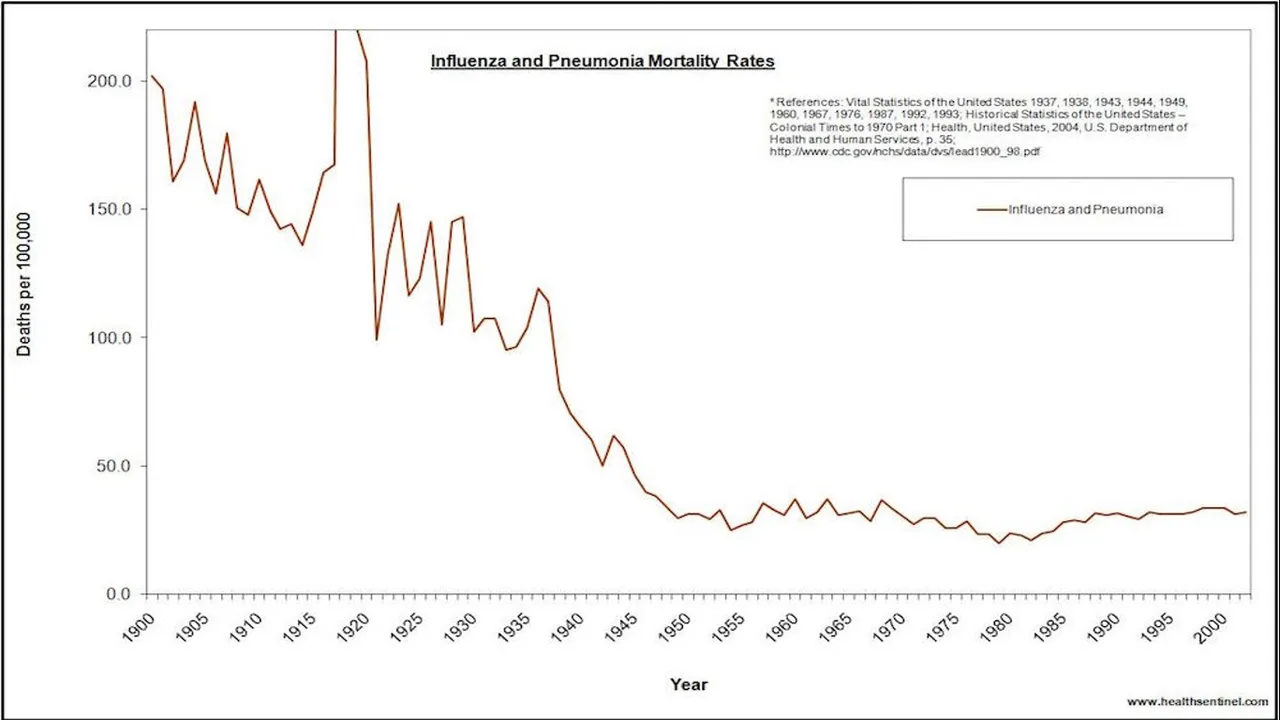
Source: postpolioproblemadediscapacidad.blogspot.com
The number of deaths from flu and pneumonia (I was unable to obtain separate data for these two) has fallen greatly. This fall occurred before 1950. This is a long time before the flu vaccine was introduced. Flu deaths have plateaued for the last 60 years. The fall in flu fatalities does not appear to be connected to the introduction of the flu vaccine. This implies that the attention given to flu is not representative of a growing problem.
I found an interesting report that even indicated that the flu vaccine actually increases a person’s vulnerability to the swine flu (abc.net.au)
Polio
The polio vaccine is often accredited with the most success. The Bill and Melinda Gates Foundation emphasize the success of the polio vaccine. One of the foundation’s goals is to rid the world of Polio using the vaccine. How do we know if the vaccine works and how can we measure its success? Looking at historical data is a good place to start. Figure 3 contains the number of Polio cases between 1937 and 2013 in the USA.
Figure 3: Polio cases between 1937 and 2013

Source: vaccines.procon.org
The data indicates a sharp decline in the number of Polio cases after the Polio vaccine was introduced. The data also indicates that the decline started before the introduction of the vaccine. Many of the claims of the success of the Polio vaccine often cite the truncated graph beginning when the vaccine was introduced. A broader picture is needed to make a better assessment of the effectiveness of the vaccine. The data can be further extended to just prior to the Great War. See Figure 4 for the Polio death rates.
Figure 4: Polio death rates between 1910 and 1975 (USA)
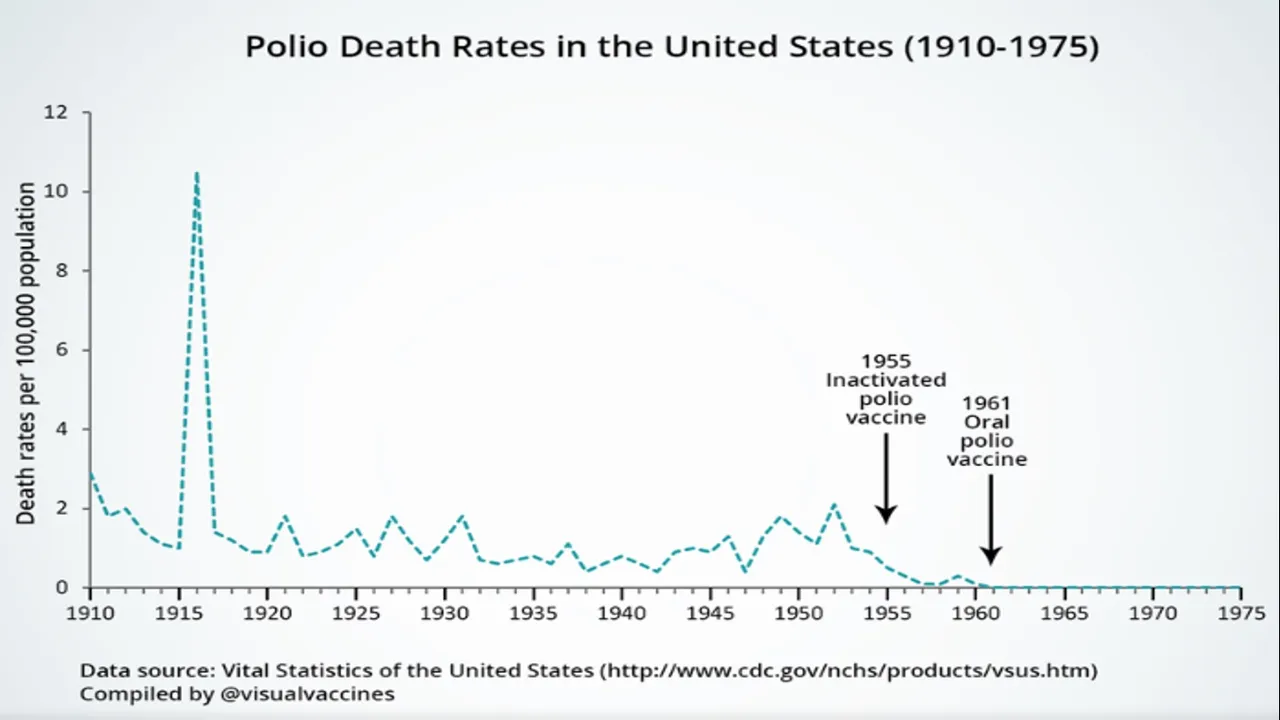
Source: medium.com
We can see that the number of polio deaths fluctuated on a yearly basis. It appears possible that Polio just happened to be declining just prior to the introduction of the vaccine. It is also possible that Polio could have spiked again if the Polio vaccine was not introduced. Since 1963, there have been no spikes in Polio outbreaks. This could be evidence of the success of the vaccine.
Change of name or definition
The Polio vaccine might appear to be effective based on the number of cases and deaths presented in the data. However, I stumbled across some other interesting information. The decline in the number of Polio cases and deaths could be caused by the redefinition of polio. Therefore, many Polio cases would not appear in the data. According to Dr. Bernard Greenberg, Head of the Department of Biostatistics of the University of North Carolina School of Public Health:
In order to qualify for classification as paralytic poliomyelitis, the patient had to exhibit paralytic symptoms for at least 60 days after the onset of the disease. Prior to 1954, the patient had to exhibit paralytic symptoms for only 24 hours. Laboratory confirmation and the presence of residual paralysis were not required. After 1954, residual paralysis was determined 10 to 20 days and again 50 to 70 days after the onset of the disease. This change in definition meant that in 1955 we started reporting a new disease, namely, paralytic poliomyelitis with a longer lasting paralysis.
Source: thevaccinereaction.org
Data can support this claim. See the graph in Figure 5.
Figure 5: Polio and AFP
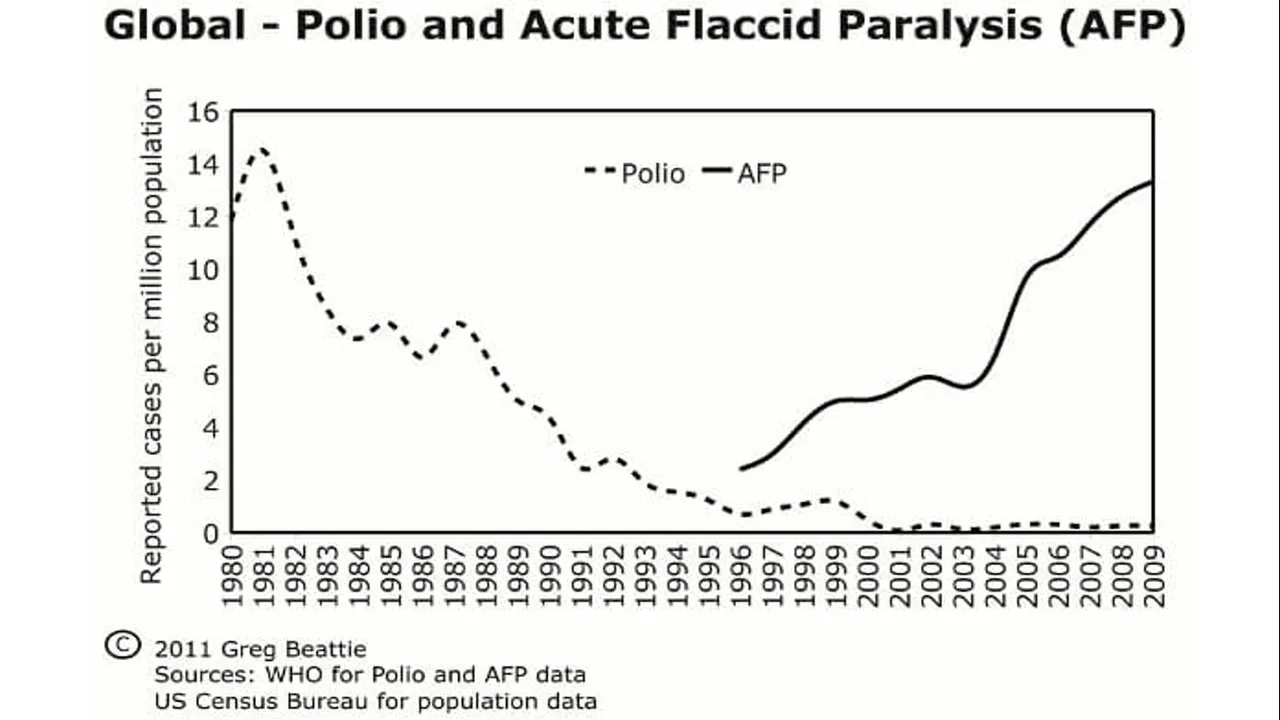
Source: avn.org.au
The increase in Acute Flaccid Paralysis (AFP) aligns with the fall of Polio. Could the decrease in Polio have more to do with the change in definition than the vaccine itself? Is AFP the new polio? I am not qualitied to give a definitive answer but the numbers presented in Figure 5 as well as the redefinition should certainly raise suspicion.
Measles
Next, I want to look at measles. Measles is included in the now infamous Measles, Mumps, and Rubella vaccine. Does the data suggest that the measles vaccine reduces the number of measles cases and deaths? The impression we get often comes from how data is presented. Figure 6 and Figure 7 both show data representing deaths from contracting measles.
Figure 6: Measles deaths and cases 1950 to 2005
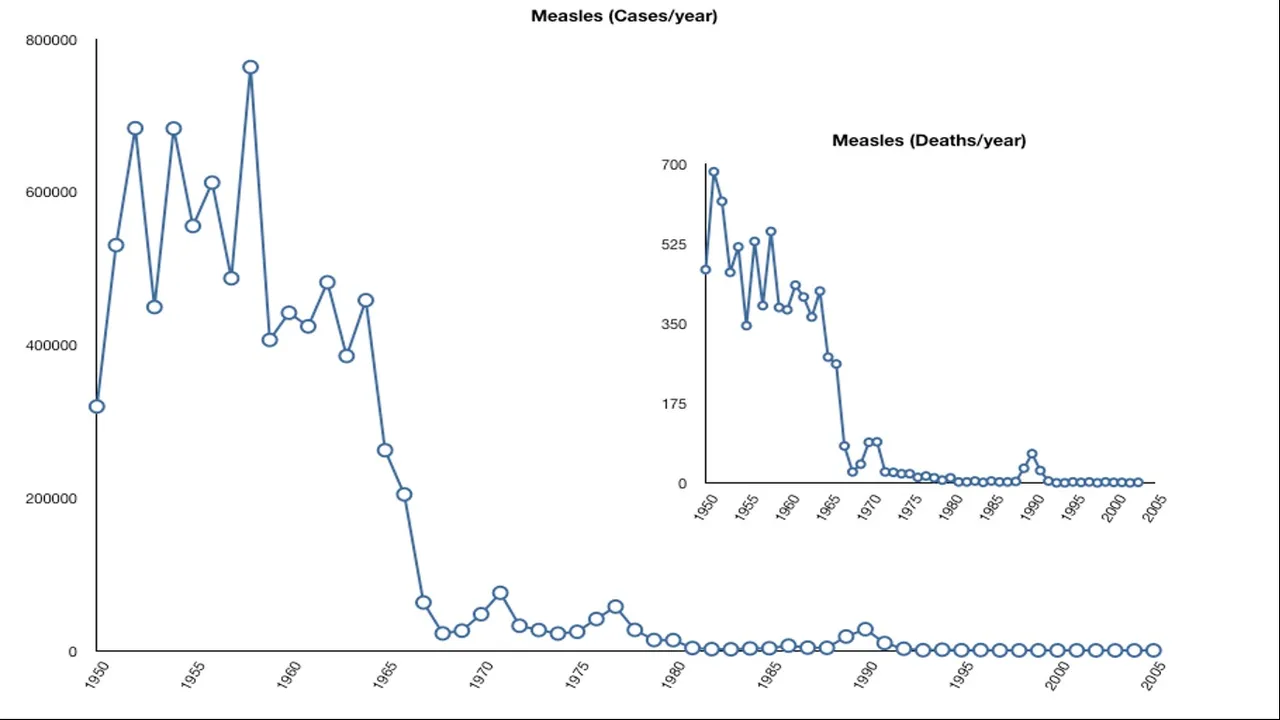
Source: vicskeptics.wordpress.com
Figure 7: Measles death 1900 to 1990
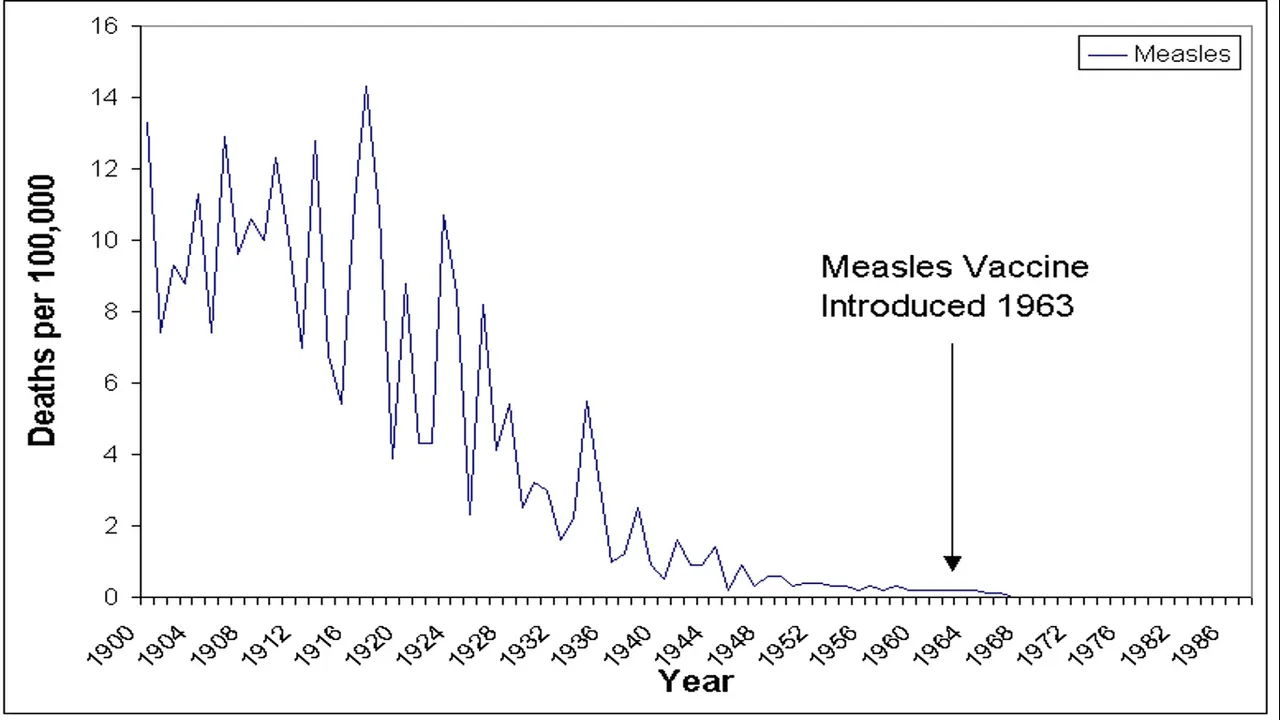
Source: nocompulsoryvaccination.com
Figure 6 would lead you to believe that the measles vaccine has greatly reduced the number of cases and number of measles deaths. Figure 7 would lead you to believe that the measles vaccine has had no impact on the number of measles deaths. Figure 7 shows the extent of the reduction in the number of deaths by measles 60 years prior to the introduction of the vaccine. Figure 6 only shows about a decade before the introduction of the vaccine. Figure 7 shows a bigger picture and could be given greater credence than Figure 6. Figure 7 still has problems that distorts the data. According to Robert Webb (vicskeptics.wordpress.com), graphs such as Figure 7 were constructed with limited data. There were gaps filled using assumptions. These assumptions are typically not explained thus presenting what looks like a complete set of data. Neither graphs can be relied upon to present an unbiased perspective of the effectiveness of the Measles vaccine.
MMR Vaccine
The MMR vaccine was introduced 8 years after the measles vaccine. At this point, Measles was close to non-existent. See Figure 8 for the introduction of the MMR vaccine in relation to the number of Measles cases in the USA.
Figure 8: Measles cases and introduction of the MMR vaccine
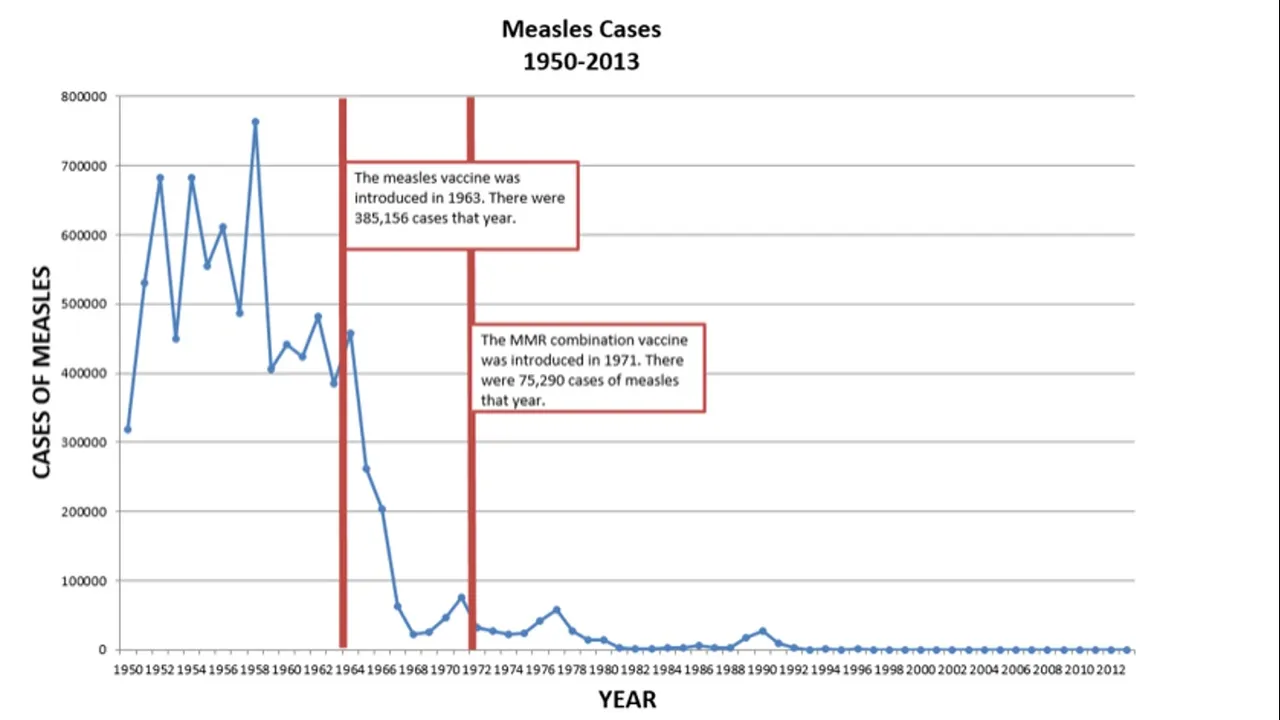
Source: vaccines.procon.org
Both Mumps and Rubella were also on the decline, which continued after the introduction of the MMR vaccine (vaccines.procon.org). Was the MMR vaccine necessary considering the decline in Measles, Mumps and Rubella? If it was necessary, should the three vaccines have been rolled into one vaccine? The documentary ‘Vaxxed’ covers the MMR vaccine in detail as well as the CDC cover up of the risks of the vaccine. The link to the video is provided in the documentary section of this post.
Small Pox
Small Pox is a great example to investigate as it was the first vaccine and has often been deemed as a great success. Figure 9 provides a before and after look at the number of Small Pox deaths in England and Wales.
Figure 9: Small Pox deaths in England and Wales

Source: childhealthsafety.wordpress.com
The data for Small Pox dates back much further than the other diseases and vaccines. The patterns of fluctuating results experienced by other diseases appears present with Small Pox as well. In the case of Small Pox, the fluctuations continue after the implementation of the vaccine. This could indicate that vaccines have very little impact on preventing disease.
Studies were also made comparing areas in the United Kingdom, which were well vaccinated and not well vaccinated. These results can be found in Table 1.
Table 1: Small Pox – Vaccinated vs. Unvaccinated
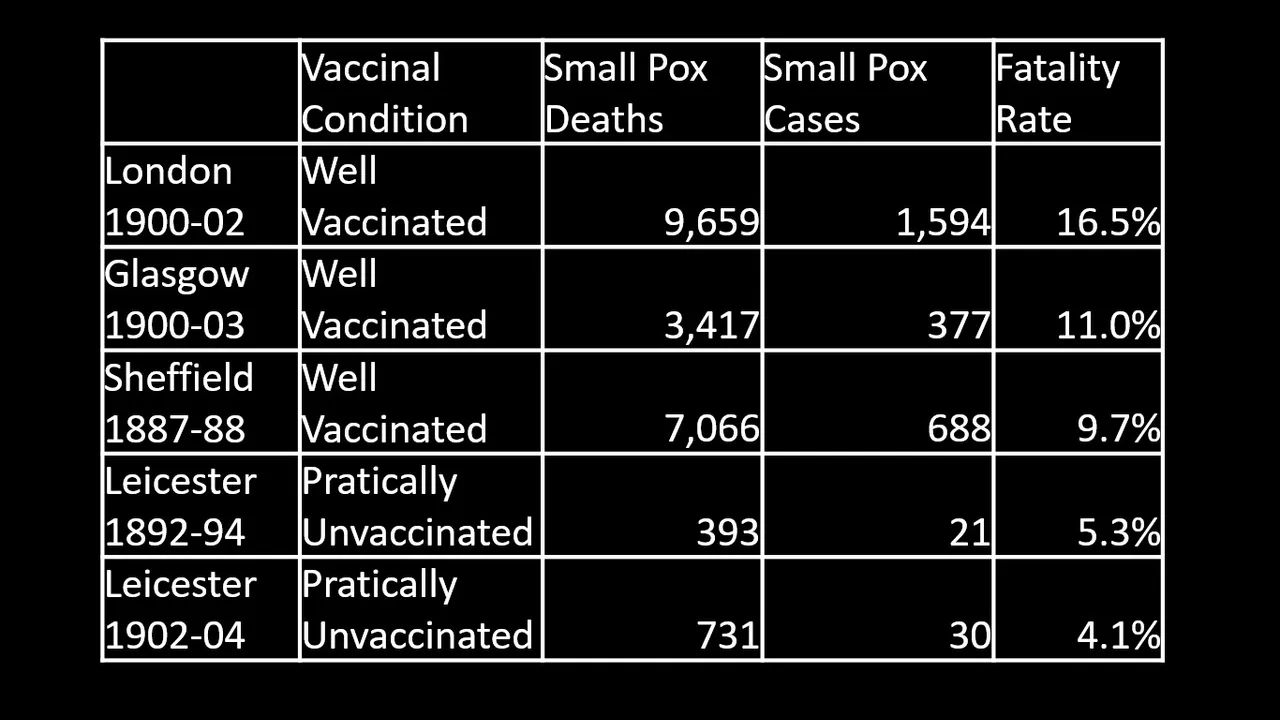
Source: childhealthsafety.wordpress.com
The data indicates that vaccinations have done little to reduce Small Pox fatalities. The unvaccinated areas had lower fatalities at particular points in time. However, the data presented appears incomplete and it is possibly biased against vaccines. It is still concerning, under any circumstances, that areas which are well vaccinated can perform worse than areas that are not well vaccinated.
General
So far, I have investigated Flu, Polio, Small Pox and MMR vaccines. There are many more vaccines to cover. If I considered all of them, this post would turn into a book. I aim to provide a glance at some of the more discussed vaccines. In this section, I want to consider the impact of a few other vaccines. For these vaccines, I will consider the time that the particular vaccine became widespread rather than when it was first implemented. Considering data from the exact point in time a vaccine is introduced, is probably not the best representation of its effectiveness. Figures 10, 11, and 12 place the periods of widespread usage into the timelines for vaccines BCG (Tuberculosis vaccine), Pertussis (Whooping Cough vaccine), and Diphtheria for Germany.
Figure 10: Widespread usage of BCG vaccines and death rates
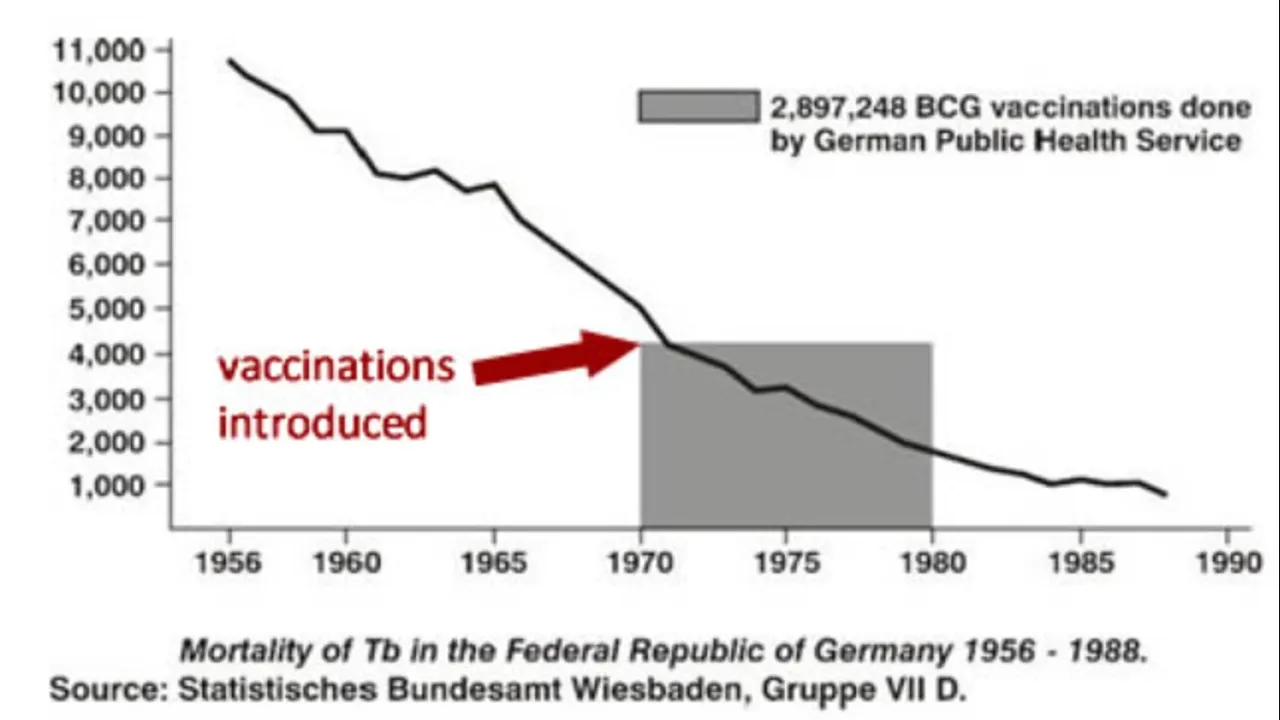
Figure 11: Widespread usage of Pertussis vaccines and death rates
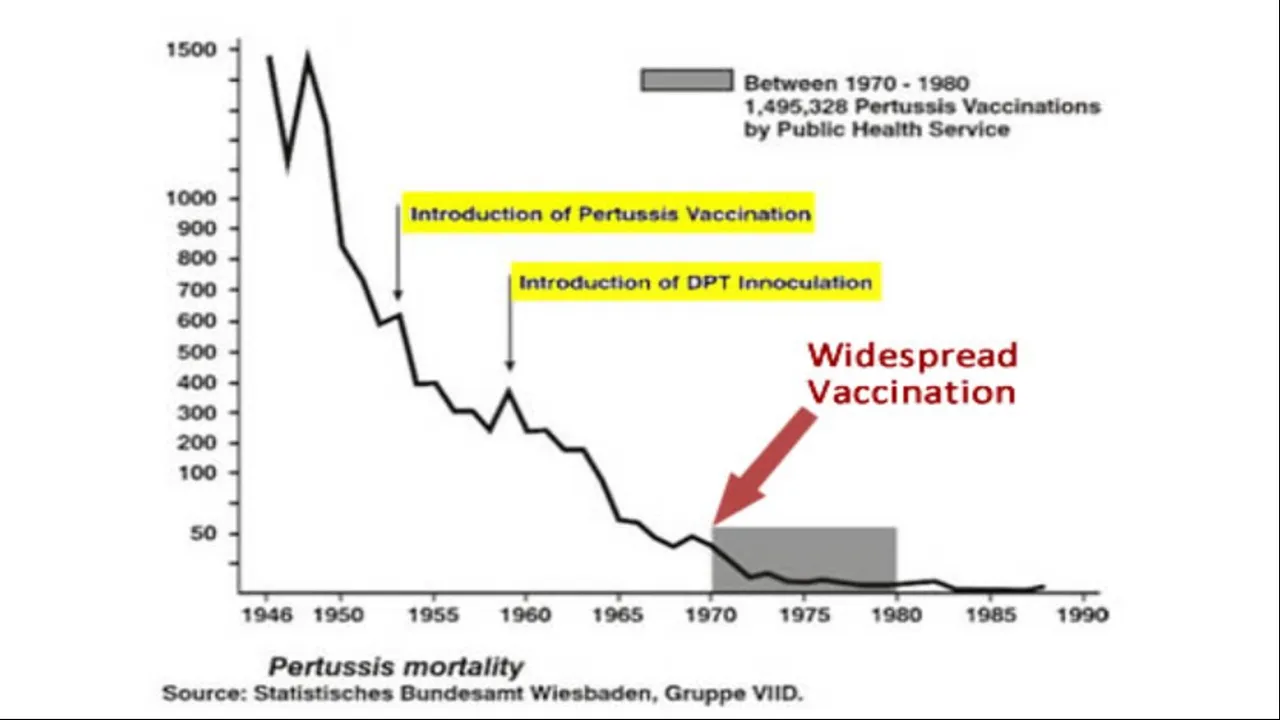
Figure 12: Widespread usage of Diphtheria vaccines and death rates

Source: preventdisease.com and therefusers.com
As with the previous vaccines discussed, the diseases the vaccines are offering immunity against are strongly in decline before the vaccines are introduced. As can be seen in the graphs above, the decline does not appear to accelerate after widespread adoption. This gives the general impression that the vaccines are not the main reason for the decline of these diseases. It is possible that some of these diseases could have restabilised themselves if vaccines had not been implemented but there does not appear to be proof that would have been the case. There is not a significantly large control group for the success of vaccines to be measured against. In the documentary section of this post, there a couple of videos that have made some comparisons between vaccinated children and unvaccinated children. The sample sizes of these groups are probably too small to draw any meaningful conclusions but the results in the videos should at least stimulate further discussion.
Possible negative effects of vaccines
Therefore, if vaccines are generally ineffective at reducing the spread of disease, do they have any negative effects? Let us look at the Small Pox vaccine. According to the Los Angeles Times (2002), there are several dangers to several groups of people. These dangers can be summarized in Table 2.
Table 2: Summary of the dangers and risks with the Small Pox vaccine
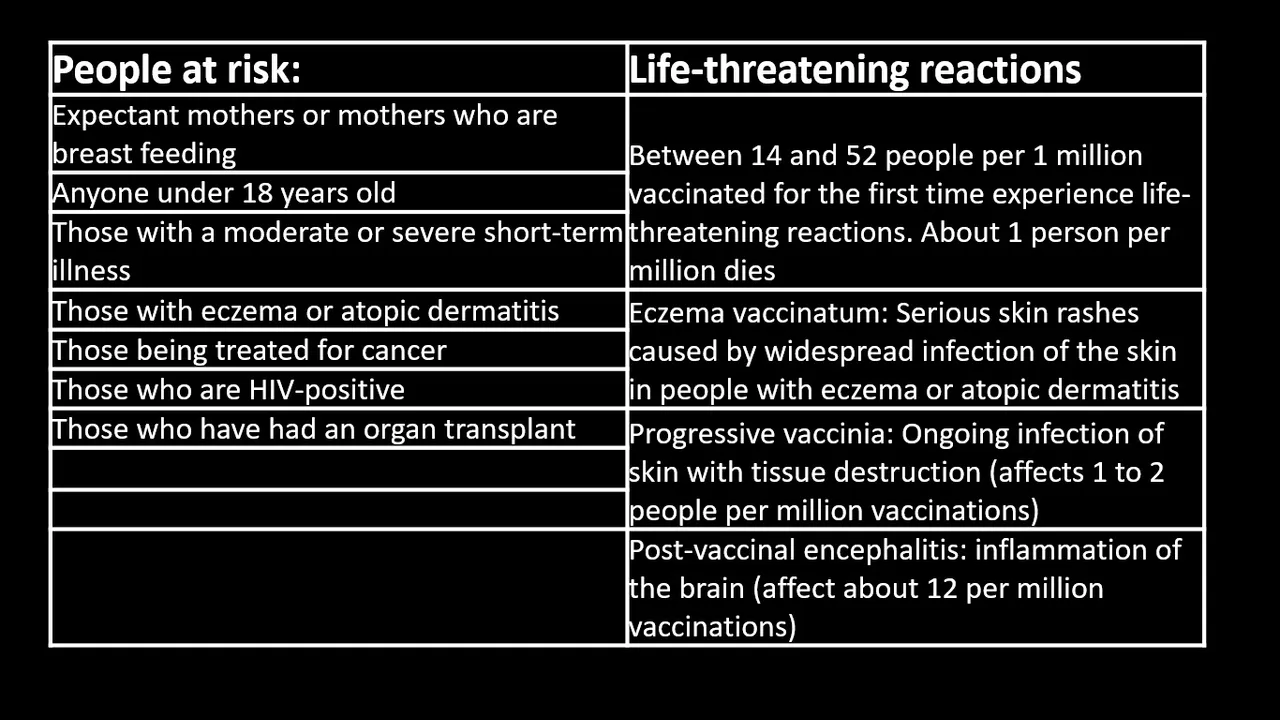
Source: ph.ucla.edu
In addition to the dangers provided by the Los Angeles Time in regards to the Small Pox vaccine, there are several other risks and dangers associated with vaccines. These dangers and risks are summarised in Table 3. This table does not approximate the likelihood of occurrence, as this varies between vaccines, but it provides some idea of what can go wrong.
Table 3: What can go wrong with vaccines?

Source: stopmandatoryvaccination.com
Pharmaceutical companies and Governments rarely explain these dangers. I discuss the logic for this later in the post.
Autism connection
One of the biggest fears regarding vaccines is the risk of Autism or probably more accurately brain damage that presents similar symptoms to the more serious end of the Autism Spectrum. Do vaccines cause Autism-like disorders? Pharmaceutical companies and Governments have adamantly denied any relationship between Autism and vaccines. Many doctors support these claims of no relationship between vaccines and Autism. They back this claim with studies, which normally provide limited information on how they were conducted. Should we just trust these claims? Why are these studies not covered in more detail for non-specialists to comprehend?
A possible approach we could take would be to investigate data, which is easier to obtain. The increase in the number of cases of Autism is a great place to start. Figure 13 contains the prevalence of reported cases of Autism in the USA.
Figure 13: Prevalence of Autism in the USA from 1970 to 2018
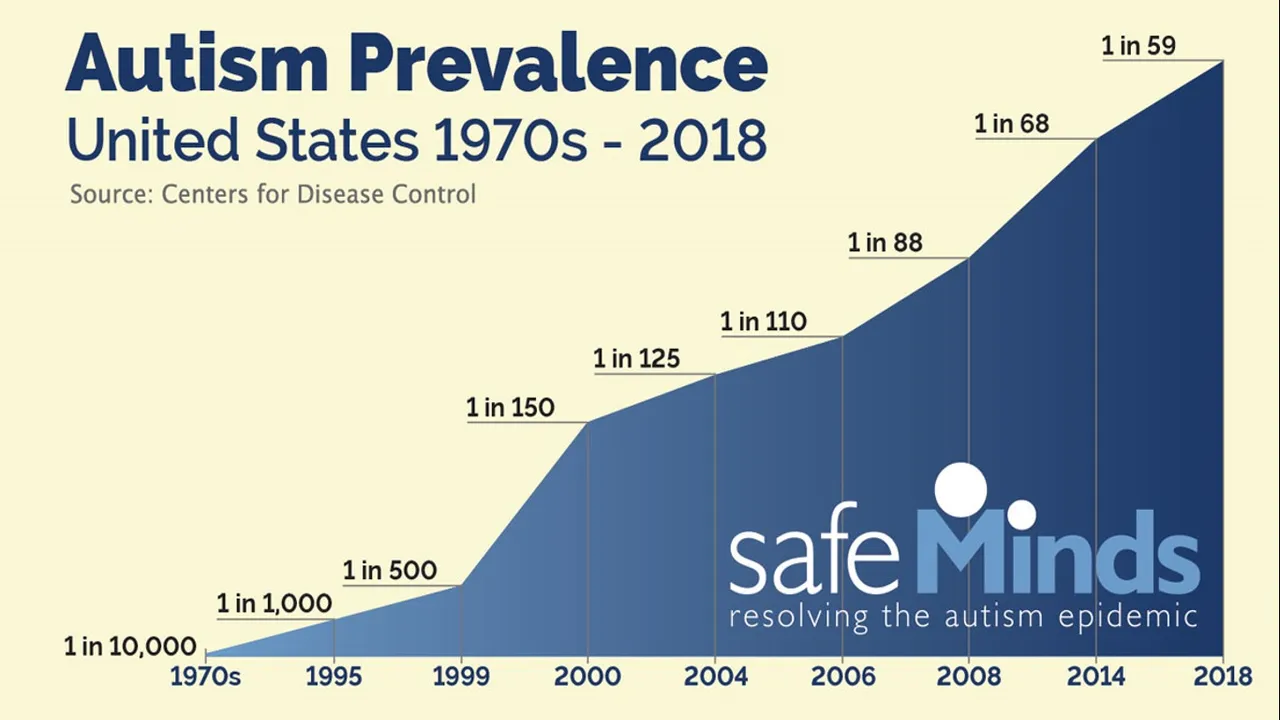
Source: safeminds.org
The increase in the prevalence of Autism from 1970 to 2018 is staggering. This increase in Autism coincides almost perfectly to the widespread use of vaccines as can be seen from the many figures shown in this post. This is not evidence that vaccines cause Autism but should be a very strong signal to conduct a thorough investigation.
How about other countries with a rapidly increasing prevalence of Autism. Do these countries have widespread use of vaccines? Figure 14 shows a comparison between developed countries and less developed countries.
Figure 14: Autism in developed and less developed countries
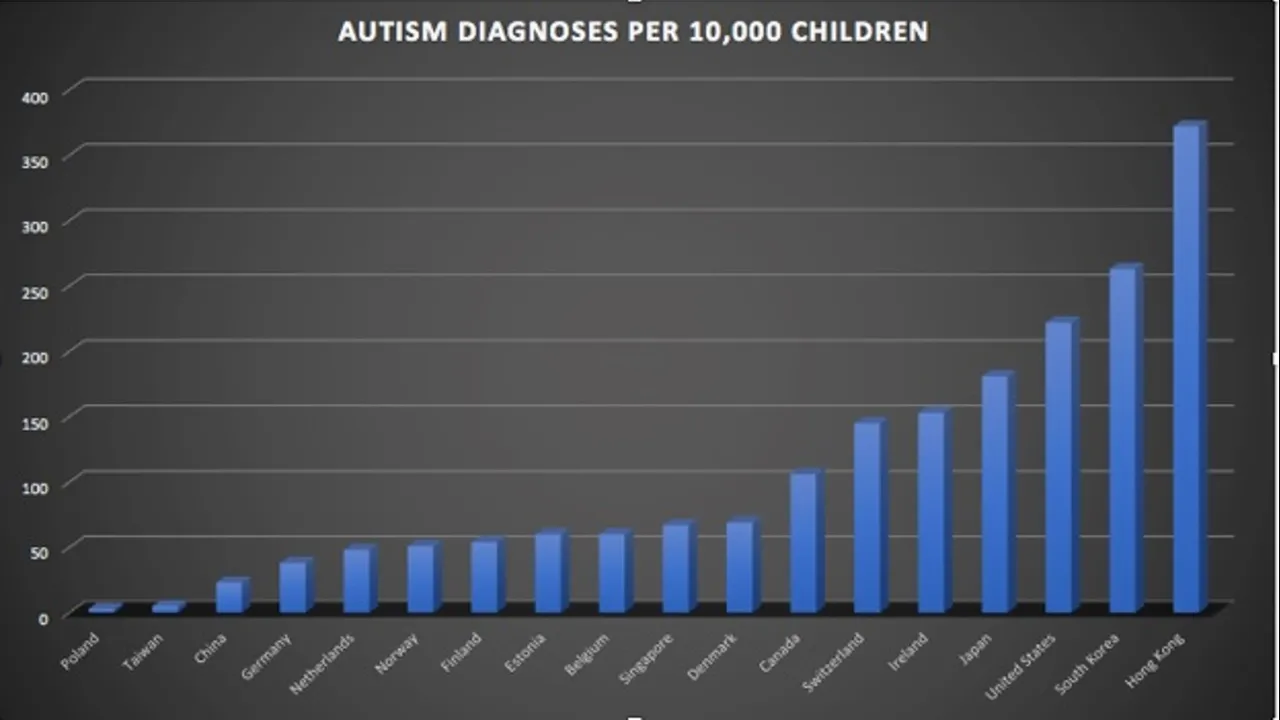
Source: focusforhealth.org
Autism is considerably more prevalent in more developed countries. These countries also have the highest vaccination rates in the world. Still, this does not mean vaccines cause Autism. Instead, it should be another strong signal for further investigation. Developed countries share a lot more in common than increased use of vaccines. It is possible that these other similarities are causing the Autism-like symptoms. Other similarities could include processed foods, birth control, and farming practices.
There are several videos/documentaries interviewing parents and families with Autistic children. Many of the parents observed Autistic symptoms in their children almost immediately after their children had been vaccinated. How many parents observed this behaviour? We can only base this information from accounts presented in the videos and other available reports. The people interviewed could be a minority or maybe there are many others still to come forward.
Vaccine schedule for children
The vaccine schedule for children has changed considerably since the 1980s. In the USA, the number of required vaccines has increased by about three times since 1983. See Figure 15 below.
Figure 15: Vaccines required then and now

Source: healthimpactnews.com
This increase is startling considering that most diseases that children are being vaccinated against barely existed in 1983. Can this be seen as necessary or are pharmaceutical companies just profiteering? Are the negative effects observed from vaccines a fault with the vaccines or are the negatives effects more related to the excessive number of vaccines administered to children at such a young age? These are the types of questions that all parents should be asking. They should not be ridiculed for doing so.
What goes into vaccines?
What actually goes into vaccines? I am sure the ingredients will vary from vaccine to vaccine. Table 4 contains a list of ingredients typically found in vaccines.
Table 4: Ingredients typically found in vaccines

Source: bmentored.com
That is quite a list of some very nasty ingredients. Current vaccine schedules are pumping these nasty ingredients into children at a concerning rate. How much of these ingredients are required before they become dangerous to a person’s health? This is yet another question left unanswered.
Quick revisit to the link to Autism (Updated 11/03/19)
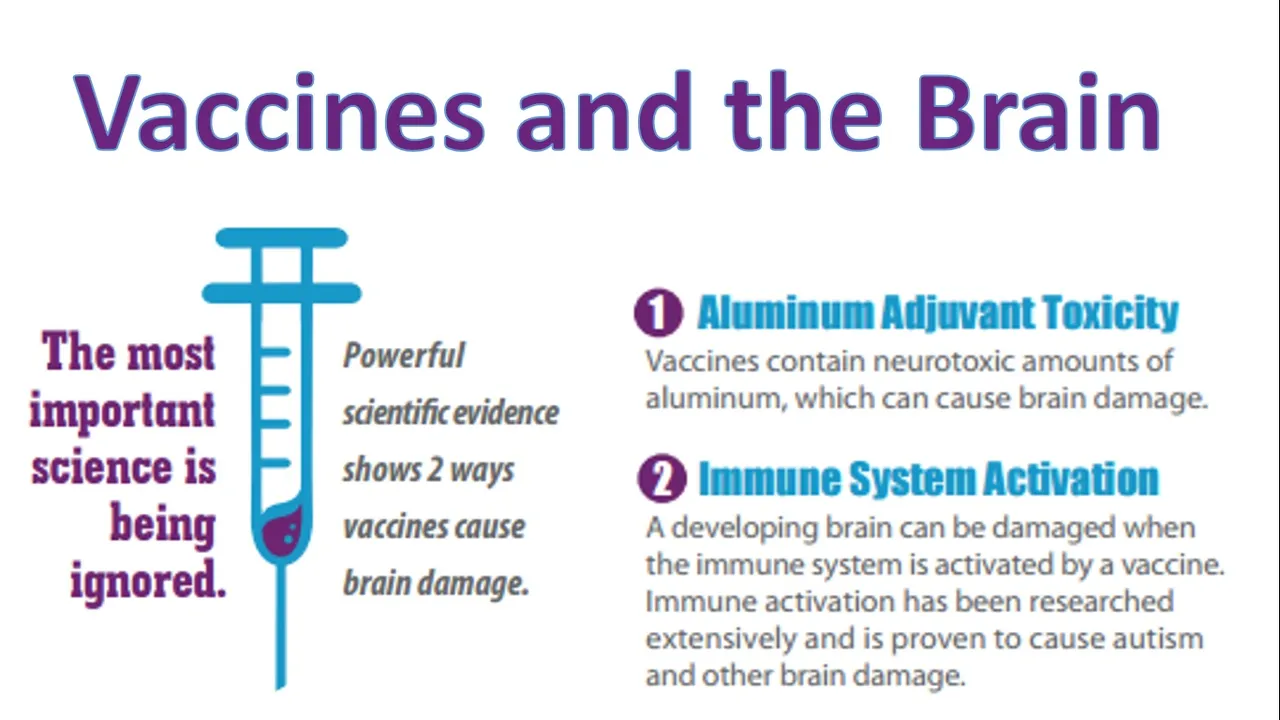
Earlier in this post, I discussed vaccines and a possible link to Autism. A key ingredient in vaccines, as can be seen in Table 4, is Aluminium. According to The Thinking Moms Revolution and supported by Vaccine Papers, there is a connection between Aluminium and brain damage linked to Autism. Aluminium adjuvants can cause inflammation of the brain, which could be causing Autism. Dr Chris Exley and his research group measured the levels of aluminium in Autistic brains. They found the levels of Aluminium to be abnormally high. A prior study conducted by Farida El Baz Mohamed revealed that levels of Aluminium in the hair of children with Autism Spectrum Disorder (ASD) to be about 5 times higher when compared to a control group.
Could the Aluminium present in vaccines be the cause of the rapid rise in Autism? Based on the studies I referenced in this post, there appears to be a strong correlation between Autism and the presence of Aluminium in the brain. Is there a sufficient amount of Aluminium in vaccines to cause Autism? In regards to the ingredients in vaccines, CDC researchers made the following statement.
‘Some parents have concerns about the safety of these ingredients, yet no large epidemiological studies have specifically examined associations between health outcomes and vaccine ingredients, other than thimerosal’
Source: ncbi.nlm.nih.gov
I think it is about time that all the ingredients in vaccines are thoroughly investigated. The evidence that vaccines are causing some form of brain damage or Autism itself is mounting. The full article investigating the presence of Aluminium in Autistic brains can be accessed using the following link:
Aluminium in brain tissue in autism
Immune System Activation
On discovery of the link to Aluminium, the same article (The Thinking Moms Revolution) also looks at something called Immune System Activation. Vaccines cause immune activation. Immune activation has been linked to Cytokine interleukin-6 (IL-6), which is produced by the immune system in response to some types of brain inflammation (Vaccines and Immune Activation). Elevated levels of Cytokine interleukin-6 (IL-6) in the brain has been proven to cause Autism (Interleukin-6 and Autism). This research aligns with the controversial studies investigated by ‘Vaxxed’, which identified a stronger link to Autism for children that are vaccinated with the MMR vaccine at an early age. If vaccines were delayed, would that address the Autism problem? It may partially mitigate the problem but far more testing is required to determine if that is the only aspect of vaccination that needs changing.
Herd Immunity

A topic typically raised by pro-vaccine groups is herd immunity. The argument is based around the idea that as more people are vaccinated, the greater the immunity to the whole groups as the disease is less able to spread. If vaccines are 100% effective, we could argue that vaccinations provide a positive externality to those not vaccinated. If vaccines are less than 100% effective but still highly effective, everyone potentially benefits from others being vaccinated but unvaccinated people still benefit the most. If vaccines are not effective, herd immunity cannot occur.
The herd immunity argument is one of the most commonly used to support mandatory vaccines and/or restricting unvaccinated children from attending school. The people that typically benefit from herd immunity based on the arguments presented are those that are not vaccinated. Those that are not vaccinated often believe vaccines do not work, therefore do not consider it a problem. The argument to protect people who do not believe the vaccine is effective is not particularly convincing. This seems like an argument to remove choice as well as earn pharmaceutical companies more money.
Interesting Documentaries
The internet is flooded with documentaries, both professional and amateur, making claims about vaccines. I have found the most informative videos are in opposition to vaccines. These videos provide examples and real life case studies of when vaccines have gone wrong. Some of these videos question the statistics and the true success of vaccines as I have done in this post. Most of the videos that support vaccines are short and simply announce that vaccines are good and that there is evidence to support that claim. These videos rarely go into any detail regarding this evidence. Instead, these videos mostly state that vaccines are beneficial.
I managed to find one reasonably well put together video explaining some evidence in favour of vaccines.
I also found one video that presents a more balanced approach to vaccines. The video did not begin with a predisposition that all vaccines are beneficial or all vaccines are dangerous. This is probably closer to the truth than being strictly in one camp or the other.
The remaining videos that I found were strongly against vaccines. Many of them presented some good arguments against them and supported these arguments with evidence. The most pivotal video to watch is ‘Vaxxed’. This video goes deep into the Centres for Disease’s (CDC) cover up of the negative effects of the Measles, Mumps, and Rubella (MMR) vaccine. The testing conducted by the CDC is limited in some regard as it compares vaccinating early to vaccinating later. They did not have a study group of unvaccinated children. Delaying vaccines appears the better option. Watch the video below.
Here are a few more videos to watch if you have time. The arguments are quite well presented.
Pharma incentive to exaggerate benefits
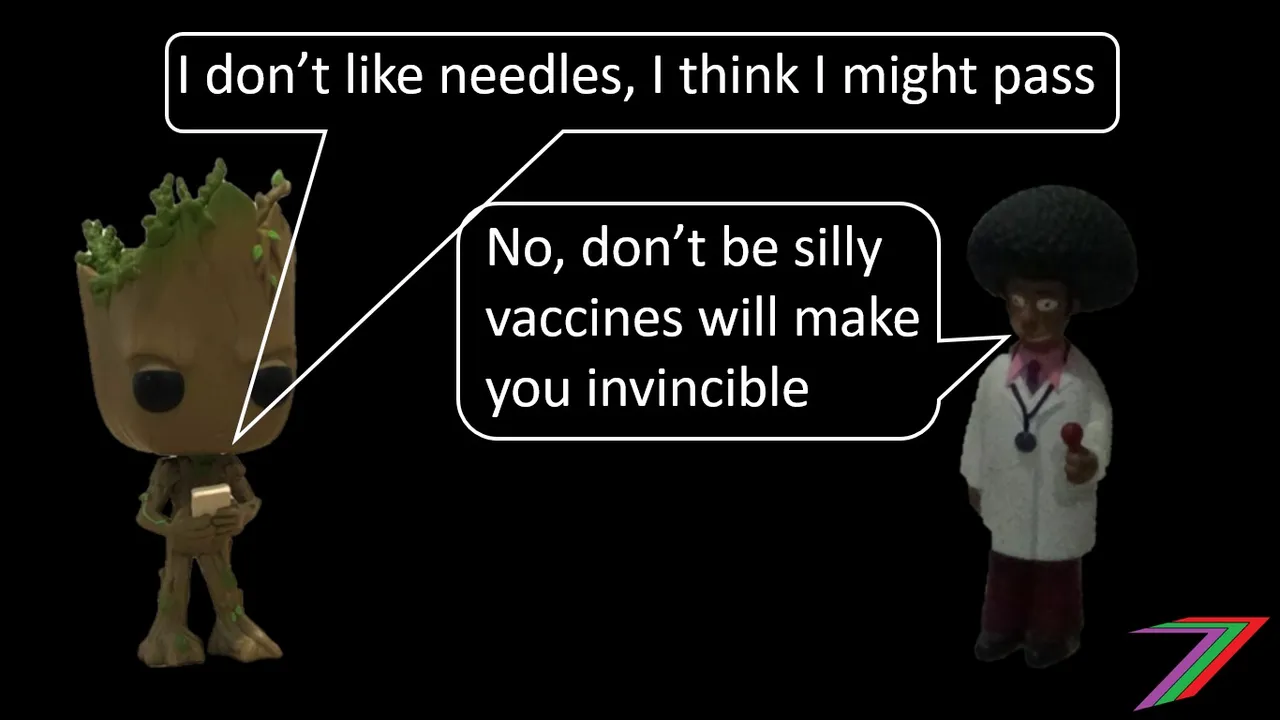
Why would pharmaceutical companies exaggerate the benefits of vaccines? Think of vaccines like any other product. Companies promote their products as if they are the best. They do this as a marketing ploy to get people to buy it. The same logic can be applied to vaccines. If people did not think they were effective, they would not buy them. For many countries, vaccines are subsidised by the Government. Therefore, they marketed as free. Of course, they are not free as taxpayer money is used to pay for them. If people refused these vaccines, the Government would not need to stock up their supply. Pharmaceutical companies would lose money.
There is definitely incentive for pharmaceutical companies to claim that their products are great. However, this does not mean that vaccines are ineffective. Pharmaceutical companies still need to offer some evidence of success. The graphs I showed earlier in the post could be interpreted as some evidence of success. For some, this evidence could be sufficient not to doubt the effectiveness of vaccines. I find the evidence inconclusive.
Why would pharmaceutical companies downplay the negative effects? The reasons for downplaying the negative effects are similar to why they would exaggerate the benefits. If people believed that vaccines could cause harm to themselves or their children, they might be inclined to reject them. Do pharmaceutical companies have a moral obligation to disclose fully all risks and the extent of these risks? Pharmaceutical companies have an obligation to make profits. If moral behaviour supports this objective, they will act in such a way. How about legal obligations? The answer should be ‘Yes” but proving the extent of the risks is difficult. The Government may not have the incentive to conduct a full investigation into the risks.
Government incentive to do nothing
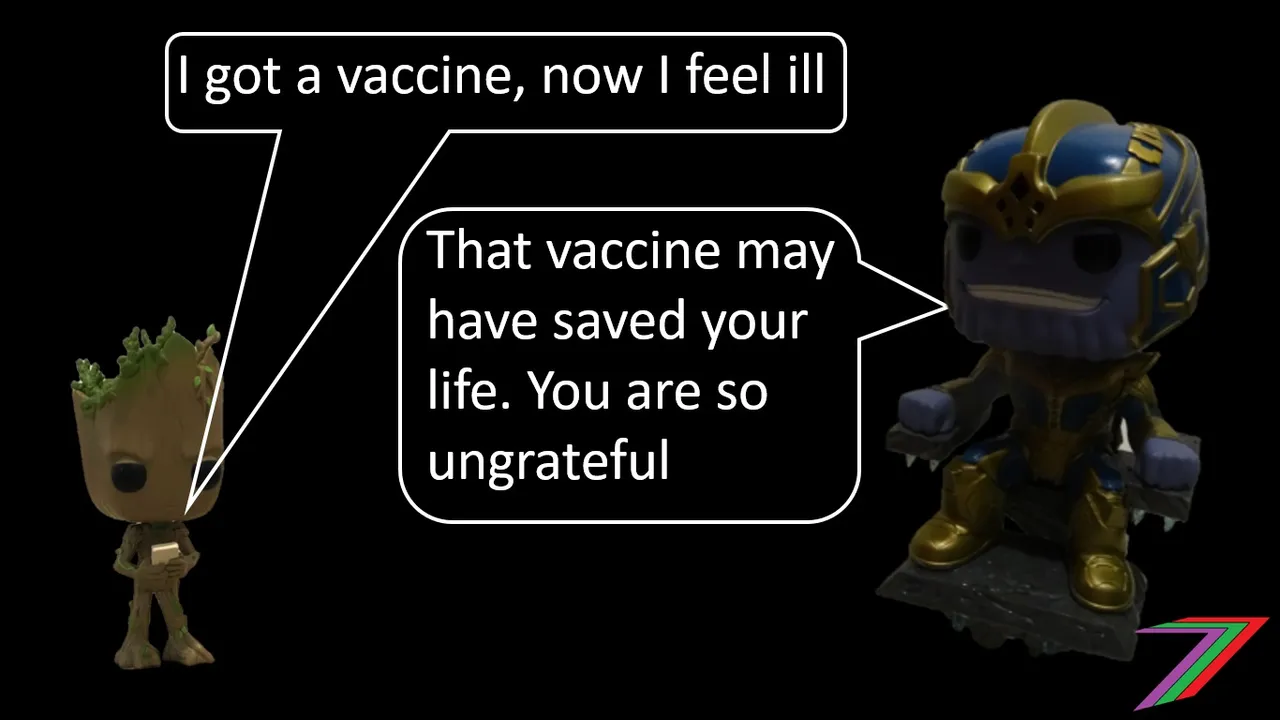
Should Governments ensure vaccines are effective and are safe to use? Government responds to the greatest pressure. If pharmaceutical companies can apply the most pressure in regards to political support, donations, lobbying etc. Governments will be inclined to support them. If people apply enough pressure that could jeopardise a political party’s position or even the establishment as whole, Government may take some form of action to ensure verifiable safety standards.
What if there is substantial pressure from both the people and pharmaceutical companies? I would expect Government to support the pharmaceutical companies. There is more incentive for Governments to have vaccines that do not work or even cause illness. Having more sick people is good for the Government as they can claim larger budgets to attempt to treatment the health crisis. From my years working in Government, I have observed that under any circumstances, treatment has been the preferred approach. Curing and solving problems is given a lower priority. Prevention is given the lowest priority. Prevention generates the least revenue and may result in budget cuts.
Both Government and pharmaceutical companies have quite strong incentives to push the argument that vaccines are effective and safe even if they are not. However, this also does not prove that vaccines are ineffective or dangerous. It just demonstrates that Government and pharmaceutical companies should not be trusted. My recommendation is to investigate and make decisions based on evidence available.
Ridicule without debate

People that question the success of vaccines or inquire into the risks are often labelled as conspiracy theorists or anti-vaxxers. They are then ridiculed as if they are crazy. If vaccines actually work, ridiculing someone for questioning them is the worst approach to take. Ridiculing someone will not change his or her mind on the subject. It is more likely to convince them that they are right. As an observer, if I see someone present a case for something, even if it is not particularly compelling or convincing, and that person is met with ridicule, I would begin to think that the person presenting his or her case could be on to something. Those that do not have facts to support their arguments often use ridicule. Ridicule is an attempt to discredit the other person without providing evidence. Ridicule is commonly used because it has some success at convincing a wider audience that the other person’s position is ludicrous and should be laughed at and not considered further.
If someone makes a claim that is obviously incorrect, it should be very easy to disprove that claim; ridicule should not be necessary.
It’s your body, it’s natural to question what goes into it

The contents of vaccines enter our bodies. We should all naturally question what is in the vaccines, and what good it could cause as well as what harm it could cause. We should also have control over what goes into our bodies. Mandatory implementation of vaccines are against human rights even if they are beneficial. If someone does not want to be vaccinated, they should have every right to deny it.
The same argument should be applied to vaccinations for children. Parents should have first say over their children’s health and not Government. Parents are more likely to care about their own child’s interests than Government. Some countries penalise children that are not vaccinated by restricting access to schools. There have been attempts to reduce allowances to families that do not vaccinate their children. It seems a typical Government response to punish those that are already suffering. If vaccines are as beneficial as claimed to be, children do not just miss the vaccine but also other benefits such as education and funding for a better life.
Conclusion

This brings me to the end of a challenging post. I felt after my visit to the Bill and Melinda Gates Foundation, I needed to dig deeper into the world of vaccines. Their foundation presented a very positive picture regarding vaccines. I presented this information unadulterated in the video and photographs. I followed up with this post, which challenges many of the claims made by the foundation as well as many of the claims of those supporting vaccines.
I also critically reviewed many of the anti-vaccinations claims. I tried to find information that was not biased by the pro-vaccination or anti-vaccination camps. Sorting through the data and information was difficult as a lot of it was skewed in a particular way to support the authors’ arguments.
In regards to the effectiveness of vaccines to prevent disease, I found the evidence inconclusive. Disease was falling before the vaccines were widespread and could have continued falling without them. The reasons for diseases to be falling prior to the introduction of vaccines should also be investigated further. I strongly suspect better sanitation and nutrition are contributing factors.
Do vaccines cause harm? There is evidence that vaccines cause harm. The extent of this harm is a little unclear. Do vaccines cause Autism? It seems highly likely that there is some correlation between Autism-like brain damage and vaccines. The occurrence of the increase in vaccines and Autism seems unlikely to be a coincidence. However, this is still not proof. The links to Aluminium as well as the effects of immune activation strengthens the argument that vaccines cause Autism. Vaccines might not be the only or even the main cause of Autism. There could be other contributing factors. If there are other factors, they need to be identified.
If vaccines were ineffective and potentially harmful, would Government take action to make them more effective, safer or ban them if that was not possible? Sadly, most Governments would not do anything. Pleasing large corporations is in their best interest financially and politically. Governments also benefit from more sick people as they can increase the size of their budgets.
I hope you found this post informative. It is very heavy on content, it could take a while to take in all the information that I have presented. If you have any questions or feedback, feel free to leave a comment below, thank you.
More posts
If you want to read any of my other posts, you can click on the links below. These links will lead you to posts containing my collection of works. These posts will be updated frequently.




Steem - The Future of DApps










